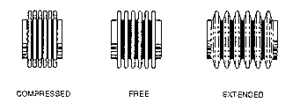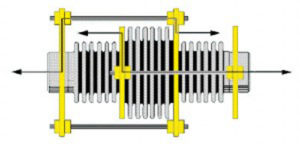Axial deflection refers to the movement of the expansion joint in regards to changes in the dimensional length of the bellows parallel to the centerline of the expansion joint.
 |
Axial deflection refers to the movement of the expansion joint in regards to changes in the dimensional length of the bellows parallel to the centerline of the expansion joint.
 |
| When there is an axial movement, the in-line bellows will start compressing and the balancing bellows will extend and vice versa. Both bellows will be moving.
|
Yes, axial as well as lateral expansion joints can be absorbed together in a single bellows design, but the lateral movement would be very minimal compared to a double or universal type expansion joint.

Read More
No, you cannot use an axial expansion joint because thrust force will be acting until the gap is closed between the tie rod nuts. When the nuts touch the lugs, the thrust force will not act upon the equipment.
Read MoreBy using an in-line pressure balanced expansion joint.
